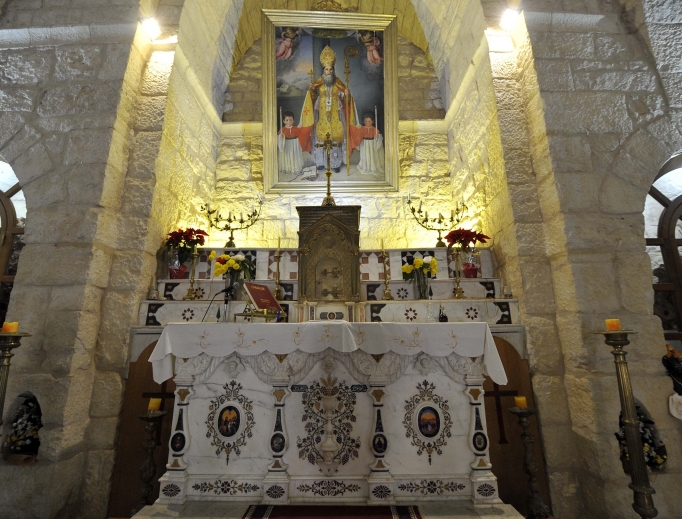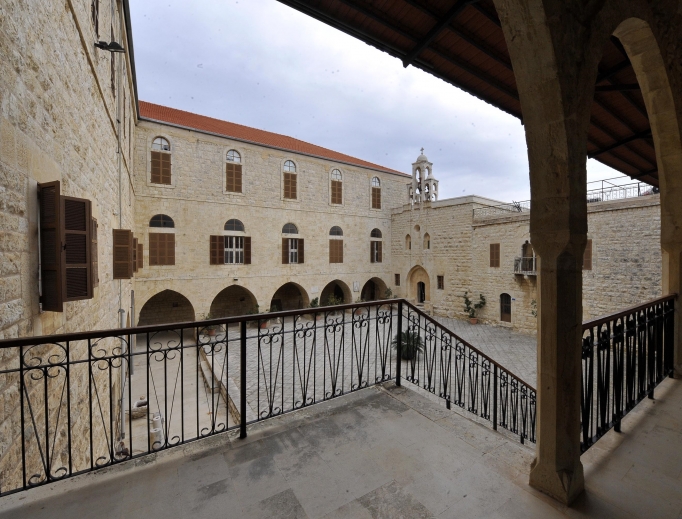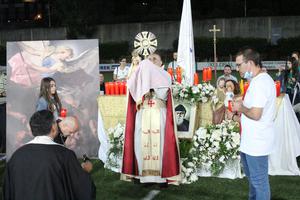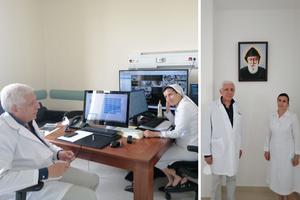Maronites Celebrate ‘Year of Martyrdom and Martyrs’
Maronite Bishop Mounir Khairallah on a conviction to continue the Christian presence.

“The blood of the martyrs is the seed of the Church.” — Tertullian of Carthage (Apologeticus, Chapter 50)
The Maronite Catholic Church is commemorating the “Year of Martyrdom and Martyrs,” extending from Feb. 9, the feast of St. Maron — the fifth-century hermit who gave his name to the Maronite tradition — through March 2, the feast of St. John Maron, the first Maronite patriarch who founded the Maronite Church in 685.
In his homily announcing the jubilee year, Lebanese Cardinal Bechara Rai, patriarch of the Maronites, said it was a unique opportunity “to renew our devotion to Christ” and to work toward “achieving love over hate, peace over war and justice over oppression.”
“We witnessed enough persecution of Christians all over the world, especially in our beloved Middle East,” Cardinal Rai said.
Maronite Bishop Mounir Khairallah of Batroun, Lebanon, the chairman of the patriarchal committee of the “Year of Martyrdom and Martyrs,” met with Register correspondent Doreen Abi Raad at St. John Maron Monastery in Kfarhay, Lebanon. The monastery dates back to 685 and was the first monastery and residence of the first patriarch, its namesake, and now serves as the bishop of Batroun’s residence.
The foundation of the Maronite Church is characterized by persecution and martyrdom. Can you share some history with us?
We have our spirituality from St. Maron, a hermit who was born in 350 (in Syria) and died in 410. His spirituality was to live in the mountains to be near to God, far from the world. This Maronite spirituality is to always lift ourselves up to God, to pray — to live in communion with God.
The disciples of St. Maron came to Lebanon beginning in 415, settling in the mountains, which provided them with a refuge ideal for their hermetic life.

In 517, the monks, disciples of St. Maron, experienced the first persecutions by brother Christians because they agreed with the Fourth Ecumenical Council in Chalcedon in 451, which decided that Jesus Christ is one Person, with two natures: divine and human. Some Christians refused this declaration of the ecumenical council. As a result, these monks were the first martyrs. This is our jubilee year — it is 1,500 years since the first persecution of Maronites.
The next wave was from the invasion of the Arab Muslims in 622 under the prophet Muhammad.
The Crusades descended upon Lebanon in 1091, coming across the Mediterranean from Cyprus to the coast of Lebanon. Then they entered the Holy Land, Jerusalem. There was 200 years war between the Crusaders and Arab Muslims. In 1291, the Mamluks came from Egypt and pushed out the Crusades from the Middle East, conquering all of this region: Lebanon, Syria, Iraq, Palestine and Egypt.
The Maronites endured a lot of persecution as a reaction to this fidelity between the Maronites and the Crusades, as well as (because of their fidelity) with Catholics in Rome and Europe. There were thousands and thousands of martyrs.
In 1367, one of our Maronite patriarchs, Patriarch Gabriel Hjoula, left his patriarchate in Mayfouq and went to Tripoli (Lebanon) to the Mamluke governor to offer his life to save his people. He was burned in the city square. That was 650 years ago, so 2017 is also a jubilee year for our patriarch martyr.
There was another wave of martyrs with the Turk Ottomans, who came in 1516 and ruled all of the Middle East as well as in Africa and Eastern Europe from 1516 to 1916, the beginning of World War I. Other Christian rites also had thousands and thousands of martyrs during this time.
How has this martyrdom affected the faith of Maronites?
The Maronites have always had a solid faith and a solidarity between themselves, and around their patriarch, always. The Maronite Church is the only church that was not separated into two branches: The Melkite has Orthodox and Catholic (Greek Catholic and Greek Orthodox); there is Armenian Orthodox and Armenian Catholic and Syriac Orthodox and Syriac Catholic. Only the Maronite Church has remained united for all the centuries and has not split.
The fidelity of the Maronite Church to the Church of Rome and to the Pope is a long story of fidelity, throughout all the centuries.

It is the Maronite Church that is commemorating the year of the martyr, but can you comment on the ecumenism of martyrdom, especially in these times in the Middle East, with the rage of the Islamic State?
[St.] John Paul II spoke of the ecumenical martyrs, and now Pope Francis is as well, because all Christians are persecuted — not only Catholics — especially in the Middle East. They are the same to Our Lord, Jesus Christ, and for us now it is an opportunity to be united as Christians in our lands. The most important thing for us is forgiveness. This is our spirituality: to forgive. To be a Christian, especially now: For us, it means forgiveness and reconciliation.
How can this forgiveness amid all the crises in the Middle East be an example for the rest of the world?
This conviviality, to live together, is so important for us. Always, always our objective has been to live together. We can demonstrate to other people and other countries throughout the world that it is possible to live together — Christians and Muslims — with all our cultural and religious diversity. It’s possible now, and it’s possible for the future.
Pope Francis has said that there are more martyrs in the Church today than there were in the first centuries. How is this affecting Christianity in the Middle East?
The martyrs of all the past centuries are the force for Christians and the Church to continue our presence and witness throughout the world.
With all the current conflicts — in Iraq, Syria, Yemen, all of the Middle East in Africa — there are so many martyrs. What Pope Francis said, unfortunately, is a reality now. But this gives us the conviction to continue our presence in this land where Jesus Christ wanted to become like us and to offer his life on the cross for all humanity.
It is our faith; it is our presence here. We are not afraid from the persecutions. Our big concern is the emigration of our people. Christians are leaving this region and immigrating to Europe, to Australia, to America. For our future, it is a big problem.
What is needed to improve the situation?
We need the world politics to be changed, especially toward the Middle East. We need a politics of peace, politics of justice, politics of freedom.
We are — as Christians and Muslims coexisting — the witnesses for freedom, for democracy, for respect of human rights. All we need is the opportunity to decide for ourselves. Change your politics, Americans, Russians and Europeans. Change your politics here. Because these politics are based on your economic interests. Stop sending arms to those groups. Otherwise, how can there be peace?
For Christians in the West, martyrdom might seem like a very “far-away” possibility, limited to the Middle East and other parts of the world. What message do you have for them?
The Church in the United States is understanding our situation here and is helping our churches, not only in Lebanon, but in all of the Middle East. The American Church has goodwill to help us to always stay in our land.
In a different way, American Christians are also suffering to live and to declare their faith. Despite the freedom, it’s not very easy to live the faith, the Catholic faith, in the West, because there is a lot of pressure from society.
We hope to have solidarity between Christians here and Christians all over the world. I am sure that, together, in solidarity, we can work for peace and justice in our time.
What are some of the ways the Maronite Church is observing the “Year of Martyrdom and Martyrs”?
We are having a lot of celebrations in honor of our martyrs. On July 30, at the summer patriarchal seat in Diman (north Lebanon), we commemorated the feast of the 350 monks, disciples of St. Maron who were martyred in 517. There the patriarch, Cardinal Bechara Rai, presented the Encyclopedia of Martyrs of the Eastern Churches, an ecumenical account (in Arabic) of all the martyrs — Armenians, Copts, Assyrians, Maronites, Greeks. It’s 1,065 pages.
We are researching history in order to memorialize our martyrs. This month (August) another book was published (in Arabic), Our Witness and Our Martyrs in Lebanon, covering 517 to 2017.
On Sept. 17, Patriarch Rai will commemorate the martyred Patriarch Gabriel Hjoula in Mayfouq (the patriarchal residence during that period.)
How can martyrs give us hope?
The martyrs encourage us to continue to be a witness to Jesus Christ. To live our faith around the world, accepting all suffering, persecutions and, like Jesus Christ, [we are called] to love everyone.
Register correspondent Doreen Abi Raad writes from Beirut, Lebanon.
- Keywords:
- doreen abi raad
- maronite church
- martyrs

















